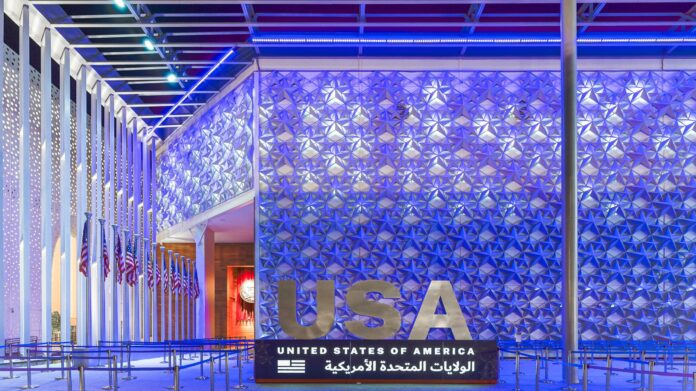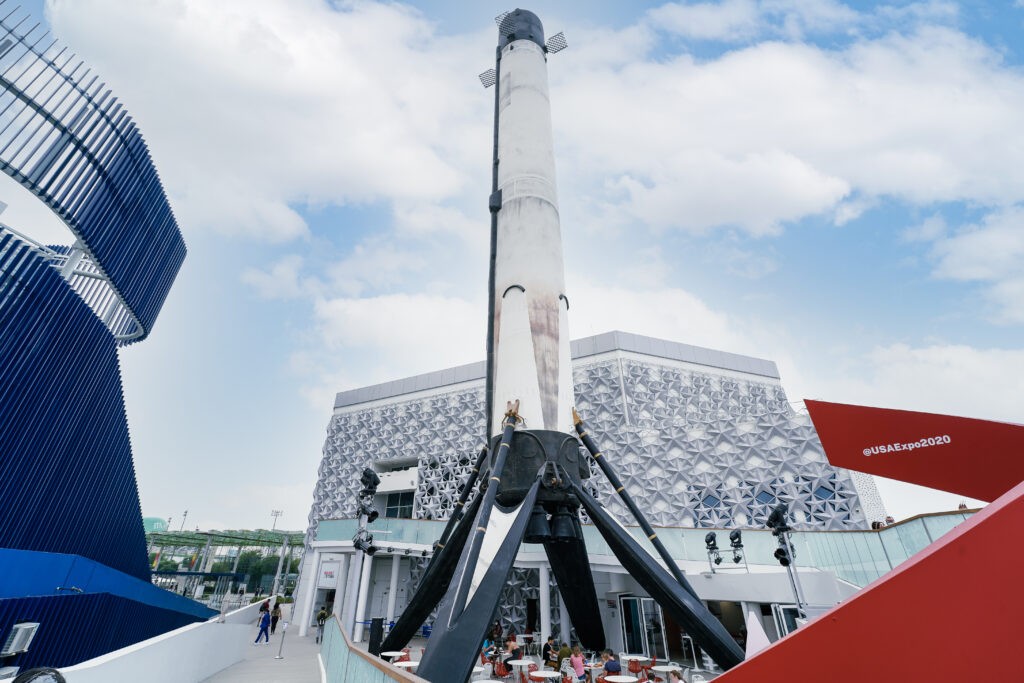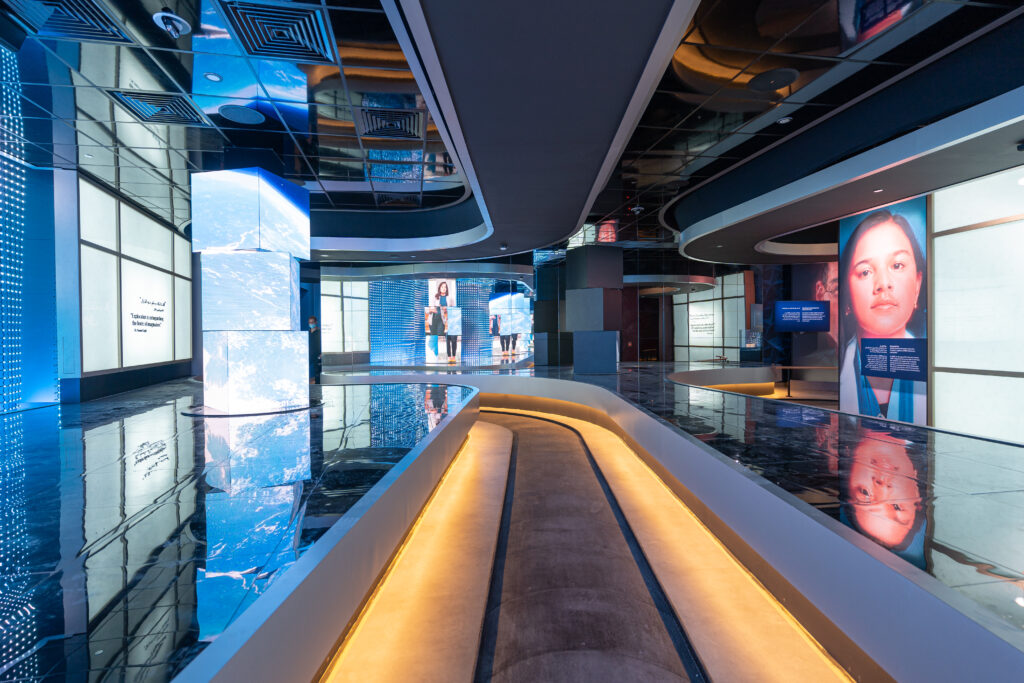Thinkwell Group turnkeys a world-class expo pavilion for the United States at Expo 2020 Dubai
interviews by James Ogul
Dubai Expo 2020 is, at this writing, near the end of its six-month run (closing March 31, 2022). Thinkwell Group (acquired by TAIT in March 2022) was turnkey designer and producer for the USA Pavilion, appointed by the U.S. Department of State.
To design, produce and finance a world’s fair pavilion is always a complex process with multiple stakeholders, looming deadlines and international logistics. The USA pavilion had its share of unique challenges — and, of course, the pandemic brought additional complications to all. Thinkwell’s team was interviewed by InPark’s in-house expo specialist James Ogul, who spent many years with the State Department overseeing the U.S. presence at world expos and has written extensively on the topic.
In this article, we hear from Thinkwell Chief Creative Officer Craig Hanna; Senior Art Director Chuck Roberts; Senior Interior Designer/Lead Show Set Designer Suzanne Wright; Thinkwell EMEA Managing Director Amin Rashmani and Thinkwell Studio Montreal Producer Antoine Roy-Larouche.
Other key team members for this project were Thinkwell Creative Director Pete Ford; Technical Lead James Duke; and Thinkwell Media VP and Executive Producer Cory Watson.
The U.S. pavilion at a world expo receives a lot of attention and expectations are high. How do you design for those expectations and make sure the bar is high enough?
Craig Hanna: The United States must be represented as a world-class presentation, but this gets carried all the way through the fit and finish, wayfinding, media production quality, and overall aesthetic of the pavilion to deliver on a high quality, entertaining, educational, and (hopefully) emotional experience.
Amin Rashmani: We worked closely with the U.S. Department of State throughout the creative process. It all started with deep dive creative charrettes, engaging not only the State’s project team, but also multiple stakeholders from museums, universities and subject matter experts. The concept was also presented at the White House for final sign-off. Throughout design and construction, State was fully engaged, informed and supportive, and the transition between the two administrations was also seamless. It was a truly collaborative effort.
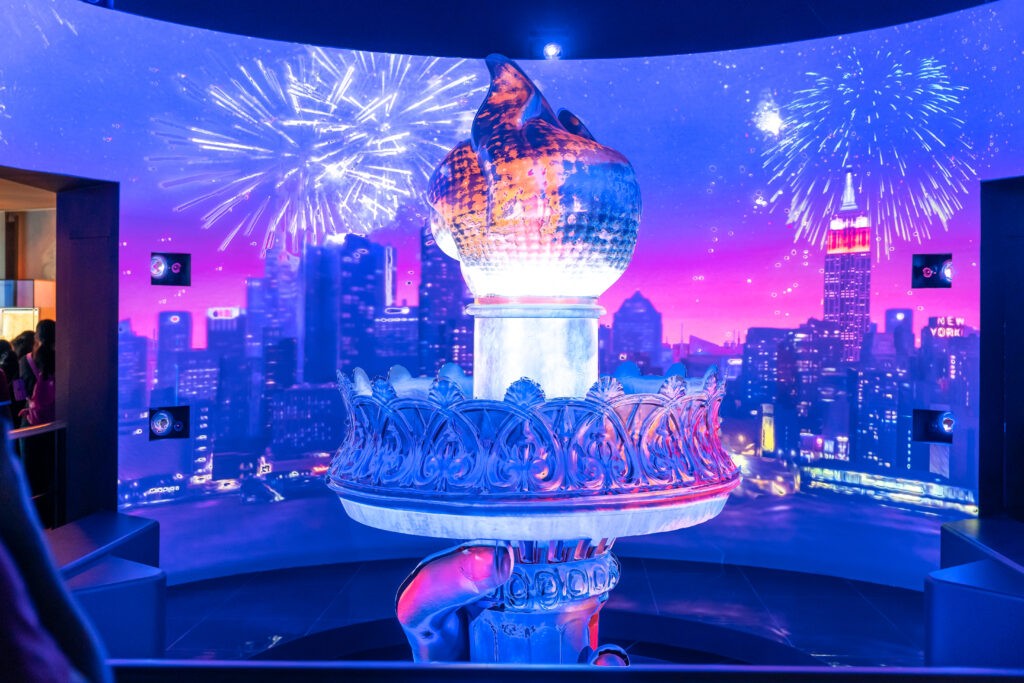
Tell us about your company’s background with world expos and why this was a meaningful project for Thinkwell.
Hanna: The idea that we worked with the State Department to help shape public diplomacy and showcase the innovation and freedoms of the U.S. to the world was a heady, rewarding experience for us. Having done a variety of commissions for prior expos, along with being on the bid team for Expo 2020 Dubai and having developed the Site Interpretive Plan, Entertainment Masterplan, and Metanarrative for the expo, it was great to dig into conceiving, creating and delivering a pavilion.
Chuck Roberts: This was the third time that I have been on a design team for a USA expo pavilion, and each time it gets better. We had the unusual opportunity to design the guest’s journey from beginning to end. You can really feel this unified sense of focus as you move through the pavilion.
Tell us about the guest experience, including the VIP area. How did you balance the needs of stakeholders and make sure the vision was fulfilled?
Hanna: It was a challenge to not only develop a pavilion that achieves living up to the lofty theme of “Connecting Minds, Creating the Future” for the Expo, but to also ensure we delivered on the sub themes of “Opportunity,” “Mobility” and “Sustainability.” We worked with the State Department to ensure that the theme and subthemes were represented in the overall guest experience in the pavilion.
Rashmani: The experience is a linear, purposely paced journey exploring the United States as the leader in individual liberty and innovation and celebrating the American entrepreneurial spirit that has influenced the world. Thematically, we wanted to reflect the expo theme and subthemes in the heart of the USA Pavilion by contextualizing the themes into the American vernacular and exploring “what’s next” for the USA and the world.
Mobility — never standing still, constantly creating the future — is at the heart of the American experience and of the USA Pavilion.
We explore the future and how that will lead to a seismic shift in the way we all live. We also explore the future of the most exciting of transport systems: space travel. To be mobile is to be dynamic.
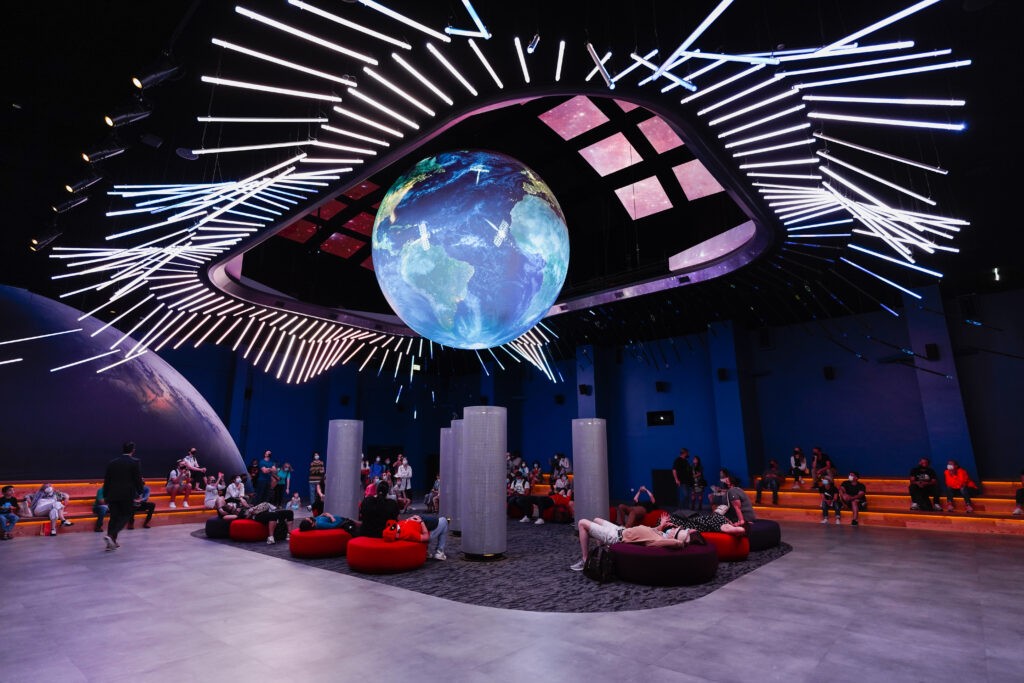
Opportunity: America is known as the land of opportunity. It creates opportunity through encouraging entrepreneurial spirit.
Sustainability is explored through the presentation of the cutting-edge technologies and thinking that is taking us to Mars. A sustainable society can and will be possible through the invention of technologies and ideas that can be used here on this planet.
As we dug deeper into the stories, we discovered that the “constant” was the idea of freedom that enables a dynamic society to live, create and prosper — the core principle upon which the United States was formed. This became the inspiration of our theme: Life, Liberty, and the Pursuit of the Future. The narrative starts with the idea of freedom and chronologically highlights American innovation. The narrative drove the spatial planning of the exhibits, and the stories were carefully curated to be told in a 20-25 minute experience.
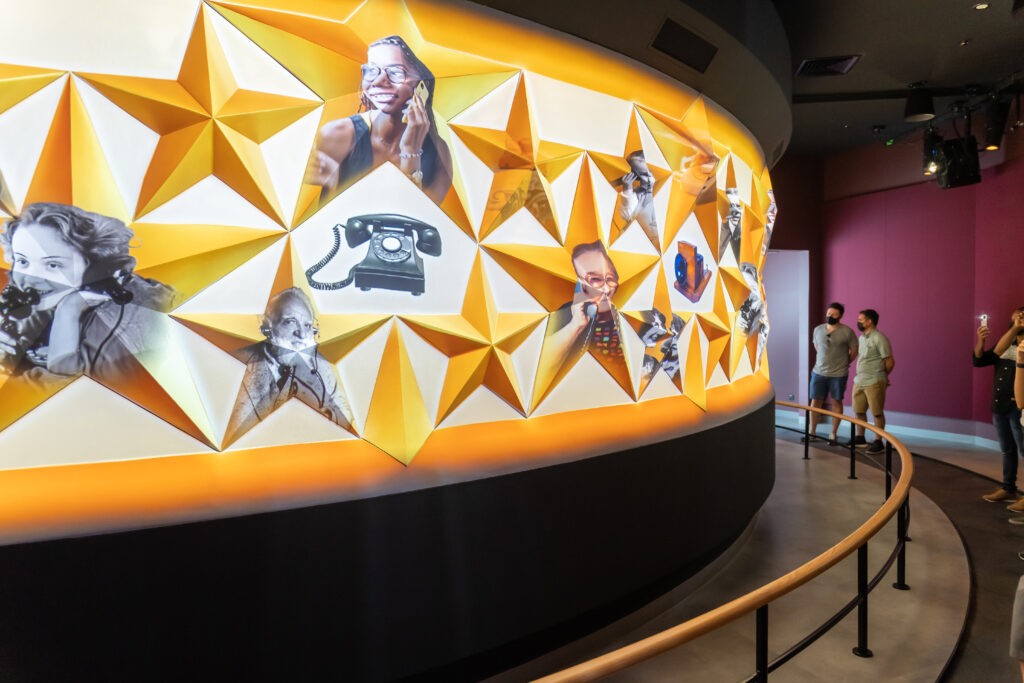
Suzanne Wright: The dedicated back entrance for VIP visitors includes conference and function areas, along with administrative offices, CG and Deputy CG office, as well as back-of-house support areas. A key driver was to provide a beautiful environment showcasing the best of American owned companies/American made manufacturing through the selected furniture and materials. All finishes were carefully selected to reflect a sophisticated American look: bold lines, a calming palette accented with rich jewel tones, subtle visual textures, dynamic mood lighting and refined decorative elements.
Roberts: We knew we had a great story to tell. The first exhibit starts small, with the guests surrounding the torch from the Statue of Liberty as we explore the concept of freedom. As we move through the next exhibits, the spaces become larger and by Exhibit Three, which focuses on today’s innovations, the guests are surrounded entirely. In Exhibit Four, which is focused on the future, the ideas are so big we had to move the show overhead! The shows really illustrate how this concept of freedom allowed the USA to contribute so much to the world.
The idea of having a full-scale replica of the SpaceX Falcon 9 was impressive. How did you work out the details of fabrication and transport to Dubai?
Rashmani: We wanted to showcase the SpaceX Falcon 9 rocket in its form as it returned from space. This was purposely done to solidify the intent of the rocket as a sustainable, reusable asset. We used reference imagery and actual photos and fabricated the rocket replica in Dubai. We engaged a structural engineering firm to design the steel structure and foundation accordingly and a scenic fabricator to build the shell. It was designed to be delivered and installed in four cylindrical pieces.
Hanna: We worked directly with SpaceX to make sure the Falcon 9 was as authentic as possible, all the way down to the aging, dirt and soiling.
Roberts: The rocket was quite a challenge. Being a replica, it required a structure of its own and then the cladding would be added on top. But the connection points and hinges for the legs are these amazing and delicate structures. Hiding the actual structure within these connection points was a bit of magic. I am very proud of how well it worked.
A moving walkway carries visitors through one portion of the pavilion. Tell us about this part of the guest experience and what influenced your design choices.
Rashmani: We wanted to purposely curate the guest journey with an uninterrupted flow. The moving walkway, slower than walking speed, was the perfect solution.
Hanna: Many participants don’t think about the capacity of the pavilion or the need to move as many people as possible through it. We think about ROI in terms of people who take in the public diplomacy message of the participant’s pavilion. Using the moving sidewalk created a “ride system” of sorts to ensure a consistent, high-capacity experience while also creating a distinctive experience feature unseen elsewhere at the Expo.
Roberts: The moving walkway was both practical and fun. The media cycles for each exhibit were timed to the walkway so everyone saw the complete show sequence. Guests really liked the novelty of the walkway. There was also room to step off the path and just watch the procession if you wanted to. And due to COVID, the walkway was very helpful. By holding each group of guests for just a few seconds before they stepped aboard, it could help to maintain safe distancing.
Tell us about some of the challenges faced and how you overcame them to get the job done.
Rashmani: The biggest challenges were predominantly related to logistics, travel restrictions, and delays in construction due to developments with COVID affecting team members, vendors and suppliers. Our mitigation strategy right off the bat involved 1) ensuring that we build additional float in our project schedule, 2) procuring the long-lead items immediately after concept development and in parallel subsequent design stages, and 3) mobilizing the core team members and international collaborators onsite early in the process to reside in Dubai to alleviate concerns around travel restrictions.
Thinkwell’s involvement began a year in advance of the initial Expo opening date. It started through advisory services to define the experience, layout and architecture (by Woods Bagot). Following this phase, Expo took over the construction of the building while Thinkwell was contracted under the U.S. Department of State to further develop and turnkey the exhibit. We worked hand-in-hand with the pavilion General Contractor (Electra) and closely integrated the project schedules and timelines.
COVID added another challenge to the initial timeline. But Thinkwellians and our collaborators across the world have long been accustomed to working while on the road, virtually and across time zones due to the nature of our international presence.
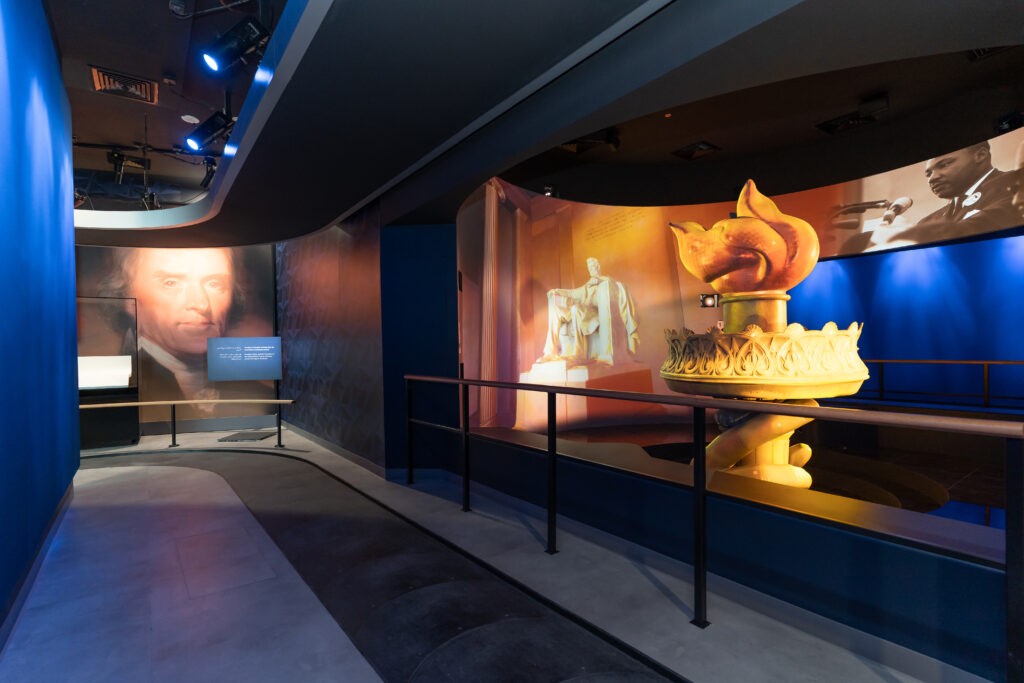
What else would you like to share about this project?
Rashmani: We were involved in the design of the building along with Woods Bagot, who designed the architectural theme and the facade. We are also involved in the operations of the pavilion.
Antoine Roy-Larouche: In addition to media production, Thinkwell’s team in Montreal led the development of the projection mapping solutions throughout the pavilion. The 3D projection mapping seen in multiple exhibits relies on Thinkwell’s patented autocalibration system. From the projection mapping studies to the integration in show control, Thinkwell’s autocalibration system solves for complexities that cannot be done by any other system on the market. The Statue of Liberty’s iconic torch had a very complex shape and was easily the most challenging piece to map at the pavilion.
In total, this project involved 26 video projectors, 21 calibration cameras and four media servers. Thinkwell also developed the show control system integration of the calibration system.
Hanna: Thank you to all who were involved in making the USA Pavilion a reality! • •
Contractors and suppliers, USA Pavilion at Expo 2020 Dubai
(provided by Thinkwell)
Architectural advisor
Woods Bagot
Fabrication firms
Mint Creative Production
Adirondack Studios
Construction
Electra Exhibitions LLC
Other exhibit and show contributions
CTME
Diligent Robotics
TECS Event Services
SpaceX
Cornell University
Zone Display Case
Maggs Bros. Ltd.
QT Luong
Hugh Fleming
Intellectual Properties Management
San Francisco Museum of Modern Art
Bharathi & Gitanjali & Bharathi Rao
Sharif Hamza
Jordan & Jen Reeves
Dr. Yvonne Cagle
Zipline
Nanoracks
Facility and fit-out
Inoksservis
Tony Gee
Glidepath
Lobo and Listone
Honeywell
National Capital Flag Co
Art Sign Works
Mohawk
Herman Miller
Kohler
Bernhardt / IFL (local sales rep)
Shipping partners
UPS
Dietl Artifact Shipping


